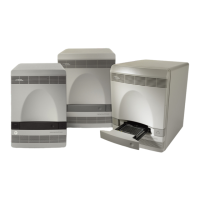Chapter 5 Generating Data from RQ Plates – 7500 Fast System
Troubleshooting
Applied Biosystems 7300/7500/7500 Fast Real-Time PCR System Relative Quantification Getting Started Guide 57
Notes
FAST
FAST
5
High variability across
the reaction plate
ROX dye was not selected as the
passive reference when the plate
document was set up
Select ROX dye as the passive reference when you set up
the plate document.
Evaporation Make sure that the reaction plate is sealed completely,
especially around the edges.
Use reagents that contain ROX passive reference dye.
High variability across
replicates
Reaction mix was not mixed well Mix the reaction mix gently by inversion, then centrifuge
briefly before aliquoting to the reaction plate.
Troubleshooting
Observation Possible Cause Action
Troubleshooting Multiplex Applications
IMPORTANT! Due to the challenging nature of multiplex applications and the complexity that can be encountered, it is
impossible to guarantee assay performance. However, the recommendations listed below should be helpful when running
multiplex applications using Fast thermal cycling conditions and the TaqMan Fast Universal PCR Master Mix (2✕), No
AmpErase UNG.
Perform the recommendations in the order listed.
When running multiplex applications:
1. Increase the annealing/extension temperature to 62 ° C.
2. If you do not obtain the expected performance by increasing the annealing/extension temperature to 62 ° C, increase the
annealing/extension time in the thermal cycling protocol by 5 seconds, to 35 seconds.
3. If you do not obtain acceptable performance by increasing both the annealing/extension temperature and time, assay
reoptimization may be required. Refer to the Real-Time PCR Systems Chemistry Guide (PN 4378658) for more
information.

